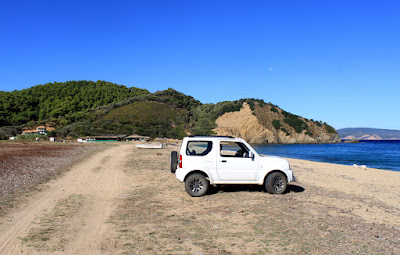Why bother to go on holiday? I asked the question on Wednesday evening after viewing the overgrown garden, the pile of letters and junk mail waiting to be sorted, never mind the dozens of emails.
And then I downloaded the pictures from two weeks in Skiathos to reveal the answer to my question. The island of Skiathos may be just 46 sq km, but many people choose to return for their holidays year after year for the simple fact that it has amongst the best beaches of the Greek islands, a large variety of tavernas, places to stay and the fact that it has a spectacular coastline that begs to be explored. The day before we left for home we too felt the pull of the island and left a deposit to secure our room for 2017.
There aren’t many bird pictures in this posting as the weather was mostly too clear and sunny for large scale migration, but there are lots of photos of the island and the places we visited. Several locals told us how there had been a lack of rain for the previous three months, a fact that became all too obvious once we began to explore in our go-anywhere Jimny and viewed the tinder dry landscape.
Don't forget to 'click the pics' for a close-up of Skiathos.
The plane’s approach took us close to the sister island of Skopelos with Skiathos Town on the right, just before the pilot turned right towards the rapid and heavily braked landing on the short, but recently extended runway.
The Bourtzi, Skiathos Town
Around The Bourtzi, Skiathos
The Old Port, Skiathos Town
Next stop Skopelos
Skiathos Town from the Airport
Arrival - Skiathos
Our host Makis Mathinou met us at the airport and just twenty minutes later we settled down in our favourite room at the idyllic, stunning and totally soothing Hotel Ostria. I am reluctant to mention this hotel on the Internet for fear of the place becoming too well known. Some secrets are best kept that way. But word does seem to have got around via the dreaded Trip Advisor, and quite deservedly, anyone wishing to stay at The Ostria must be quick off the mark to reserve a room.
The hotel has resident Hooded Crows and plays host to Scop’s Owl, Little Owl, Spotted Flycatcher, Chiffchaff, Blackcap and Red-backed Shrike. It also offers free drinks from the swimming pool to Barn Swallows and Red-rumped Swallows and on occasion, Bee Eaters which join the swifts and swallows overhead in the hunt for flying insects. We had one sighting of Bee Eaters this year when a party of eight or ten flew around before heading off towards the nearby shore.
The hotel has resident Hooded Crows and plays host to Scop’s Owl, Little Owl, Spotted Flycatcher, Chiffchaff, Blackcap and Red-backed Shrike. It also offers free drinks from the swimming pool to Barn Swallows and Red-rumped Swallows and on occasion, Bee Eaters which join the swifts and swallows overhead in the hunt for flying insects. We had one sighting of Bee Eaters this year when a party of eight or ten flew around before heading off towards the nearby shore.
The Ostria, Agia Paraskevi
Hooded Crow
We had a super two weeks and even though the weather turned a little dodgy in week two with a couple of mornings of heavy rain to disrupt migration, the birds never arrived in any numbers. Even after downpours the landscape remained dry and parched with a lack of standing water where migrants might normally be found.
On a number of days we called in at Aselinos and the tomato farm near Xanemos beach and found Yellow Wagtail, Whinchat, Willow Warbler, Chiffchaff, House Sparrow and Red-backed Shrikes, together with Barn Swallows, Swifts and Red-rumped Swallows, plus the ubiquitous Hooded Crows. The cliffs at the tomato/pepper farm are a good spot to watch for gulls and Eleonora’s Falcon as it’s not far from the falcon’s stronghold of Kastro just along the coast. Yellow-legged Gull is the neighbourhood gull of Skiathos but unlike our closely related UK Herring Gull, the Yellow-legged Gull of Skiathos remains wary of human contact and wouldn’t dream of snatching a sandwich.
On a number of days we called in at Aselinos and the tomato farm near Xanemos beach and found Yellow Wagtail, Whinchat, Willow Warbler, Chiffchaff, House Sparrow and Red-backed Shrikes, together with Barn Swallows, Swifts and Red-rumped Swallows, plus the ubiquitous Hooded Crows. The cliffs at the tomato/pepper farm are a good spot to watch for gulls and Eleonora’s Falcon as it’s not far from the falcon’s stronghold of Kastro just along the coast. Yellow-legged Gull is the neighbourhood gull of Skiathos but unlike our closely related UK Herring Gull, the Yellow-legged Gull of Skiathos remains wary of human contact and wouldn’t dream of snatching a sandwich.
Aselinos, Skiathos
A dodgy morning near Xanemos
Eleonora's Falcon
Yellow-legged Gull
On other days we explored the unmade roads and tracks of the wild north coast to the beaches of Kanapitsa, Kechria, Ligaries and Agistros where we came across more shrikes, flycatchers and Whinchats but this time with Common Whitethroat, Blackcap and Lesser Whitethroat amongst the Chiffchaffs. There are one or two pairs of Ravens on the island, birds which alerted us to the presence of on high Honey Buzzards, a Kestrel and more Eleonora’s.
On our journeys we we found similarly minded people, not birding, but simply exploring and enjoying the landscape, mostly in the obligatory Jimny. Anyone thinking of driving in Skiathos, dont worry. The only things to be be wary of are taxi drivers on flight days, tourists strolling along the narrow streets of town, or helmetless locals riding motorcycles. Sticking to rules is not something the Greeks enjoy.
On our journeys we we found similarly minded people, not birding, but simply exploring and enjoying the landscape, mostly in the obligatory Jimny. Anyone thinking of driving in Skiathos, dont worry. The only things to be be wary of are taxi drivers on flight days, tourists strolling along the narrow streets of town, or helmetless locals riding motorcycles. Sticking to rules is not something the Greeks enjoy.
Which Way? - Skiathos
Skiathos goat
Agistros - Skiathos
Whinchat
Jimnys- Skiathos
Kechria - Skiathos
Spotted Flycatcher
Looking for warblers- Skiathos
Kanapitsa - Skiathos
Skopelos and Tsougria viewed from Kanapitsa - Skiathos
Skiathos is a captivating island that has great charm, a fascinating history, wonderful beaches, a friendly and civilised population and one that boasts an amazing array of tavernas in which to spend an evening. I heartily recommend it to readers. In fact, I’ll drink to that. Cheers everyone!
Dish Of the Mum - Skiathos
Tourists - Skiathos













































































.jpg)












